One of the most arresting natural monuments in Switzerland feels strangely out of place. Far away from the country’s trademark alpine landscapes, breathtaking glaciers, and picturesque valleys, it is located on the outskirts of Zurich. Situated in between the airport and a major rail junction, the monument hides in the inconspicuous Leutschenpark.
On my way to the site, I stroll through the Seebach quarter, with its modern housing complexes, straightened rivers, and corporate high-rises. The aesthetics of the Leutschenpark itself are defined by clinically drawn paths, geometric-shaped benches, and a futuristic light installation, whose overhead glowing tube traces the paths as I walk. A world tinted gray unfolds as I stroll along those Euclidean walkways. There is concrete everywhere, from the path under my feet to the fountain and a small stage—even the playground is sealed with it.
In the very middle of the all-encompassing gray, a group of grand trees stands silhouetted against the sky, high-branched heads full of leaves, each one soaked in a different hue of vibrant autumn. Even standing 50 meters away, I can sense their gravitational pull. I had seen images of Leutschenpark before online, but its peculiarity is still baffling to behold in person: The trees in the center of the park are blocked off by an ominous concrete barrier. It must be at least three meters high. Despite knowing better, I round the curved wall looking for an entrance. But after coming full circle, I have to concede—there is no way to get inside. No official gate, not even a concealed concrete door. Now, what kind of landscape feature would demand so much security? Is it a prison for trees? A land art piece? A hidden small-scale attempt at rewilding?
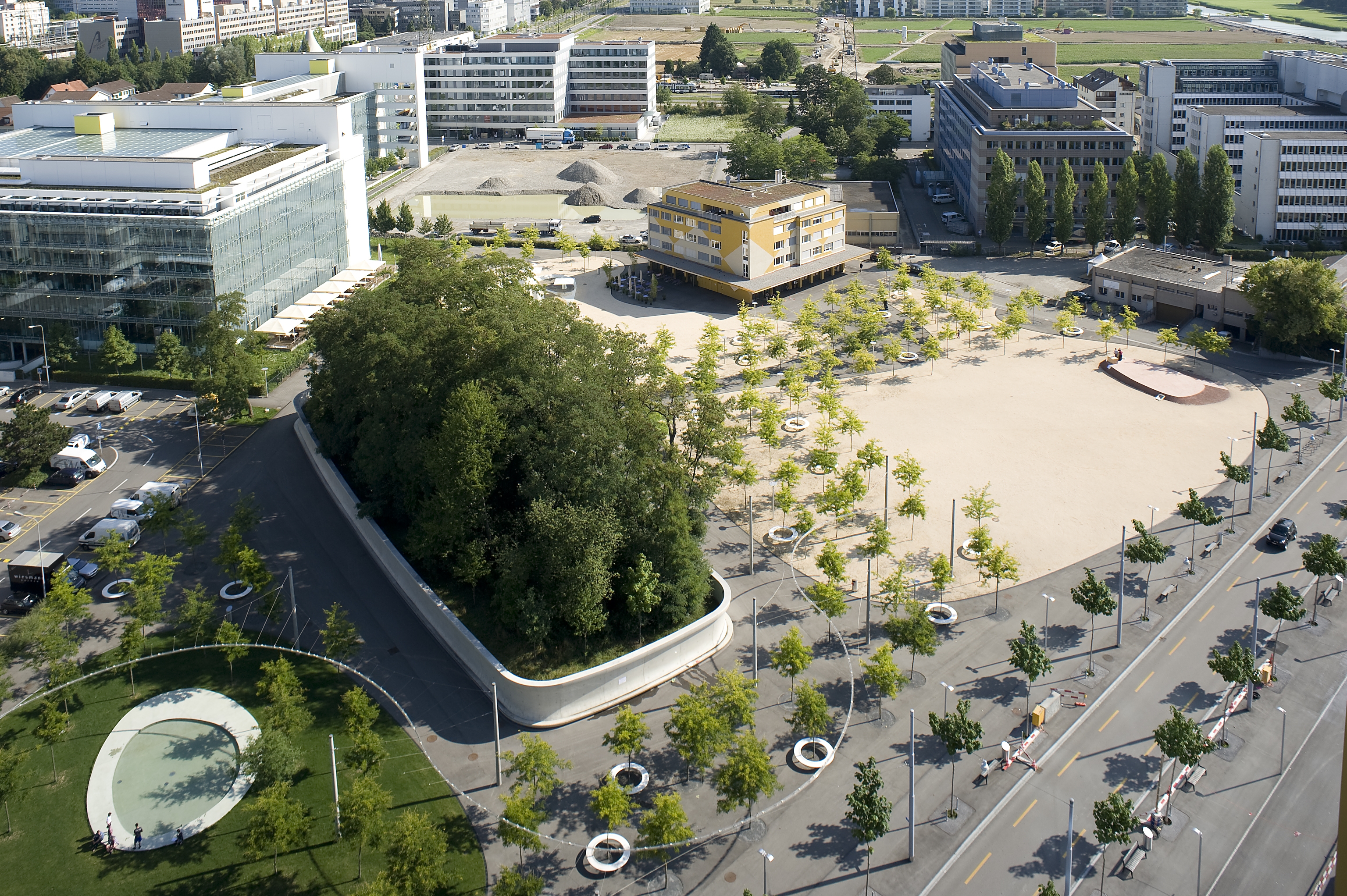
History hides in plain sight
As I am to learn, the truth lies far from my speculations. The tall trees behind the wall are what remains of the Büel-Seebach shooting range. More precisely, these trees are growing upon a small hill that is an outdated version of what’s known as a bullet trap. If you are not a sport sharpshooter, chances are you have never heard this term before. But bullet traps are probably the most essential structures for shooting ranges, since they are placed directly behind the targets to stop projectiles. They prevent smashed windows and shot-through facades, and, more crucially, any danger to the life and limb of curious passersby—mostly.
But make no mistake, in most cases bullet traps are nothing more than a simple heap of soil. At Büel-Seebach, stacks of earth were excavated directly on-site and raised as a wall when the range was built in 1899. During the range’s peak years in the early 1950s, up to 4,000 soldiers, hunters, and shooting enthusiasts would fire their guns there, making the earth wall swallow tens of thousands of projectiles. The incessant riflery lasted until 1954, when intensifying urbanization in Seebach called a halt to the shooting. Bigger streets, increased traffic, and newly built residential blocks near the shooting ground meant too many dangers to the public. The military—which operated the range—decided to abandon the site and replace it with a newly built, safer shooting range close by. But even though Büel-Seebach was closed down, the story of the bullet trap was far from over.
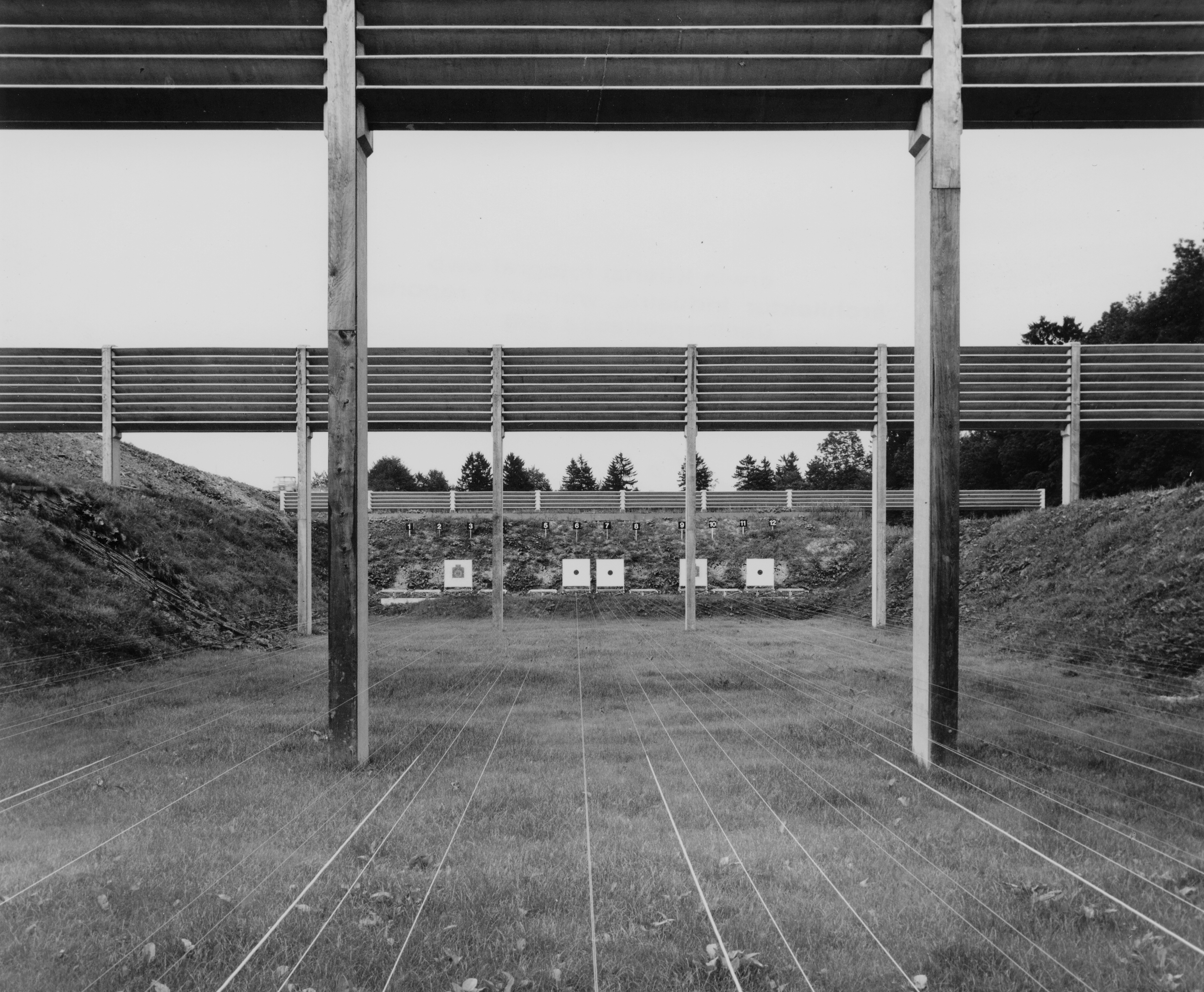
After the range was closed, a problem loomed: the earth wall behind the targets was highly toxic. Fifty-five years of shooting had left tons of projectiles—composed of the poisonous heavy metals lead and antimony—buried within. The immediate surroundings of the bullet trap were especially affected. There, the dense concentrations of lead equaled those found in industrial lead mines, surpassing today’s standard safety limits by a hundredfold.
The local authorities came up with a rather curious solution: by fencing off the site, they believed, they would prevent humans and nonhumans alike from coming in contact with the toxic soil. If this sounds dubious to you, it is. Scenarios such as a storm carrying contaminated earth into neighboring areas, strong rains activating the heavy metals, or simply some adventurous kids climbing over the fence were apparently deemed neither very likely nor dangerous enough. Local historians claim that the toxic area was not even declared as such with a warning sign.1 For decades after its closing, Büel-Seebach likely appeared as just an odd wasteland, even as parking lots and small houses were added to the surrounding area in the 1980s, and a community of Roma people lived close by with their livestock until the early 2000s. Yet despite the threat posed by the toxic soil, it remains hard to establish whether any harm was caused. After all, there were no major incidents reported. And perhaps it was this lack of any spectacular page-turning lethal event—no immediate human deaths nor masses of animal poisonings—that led local residents to accept a simple wire-mesh fence as their only protection against a highly toxic hill for several decades.
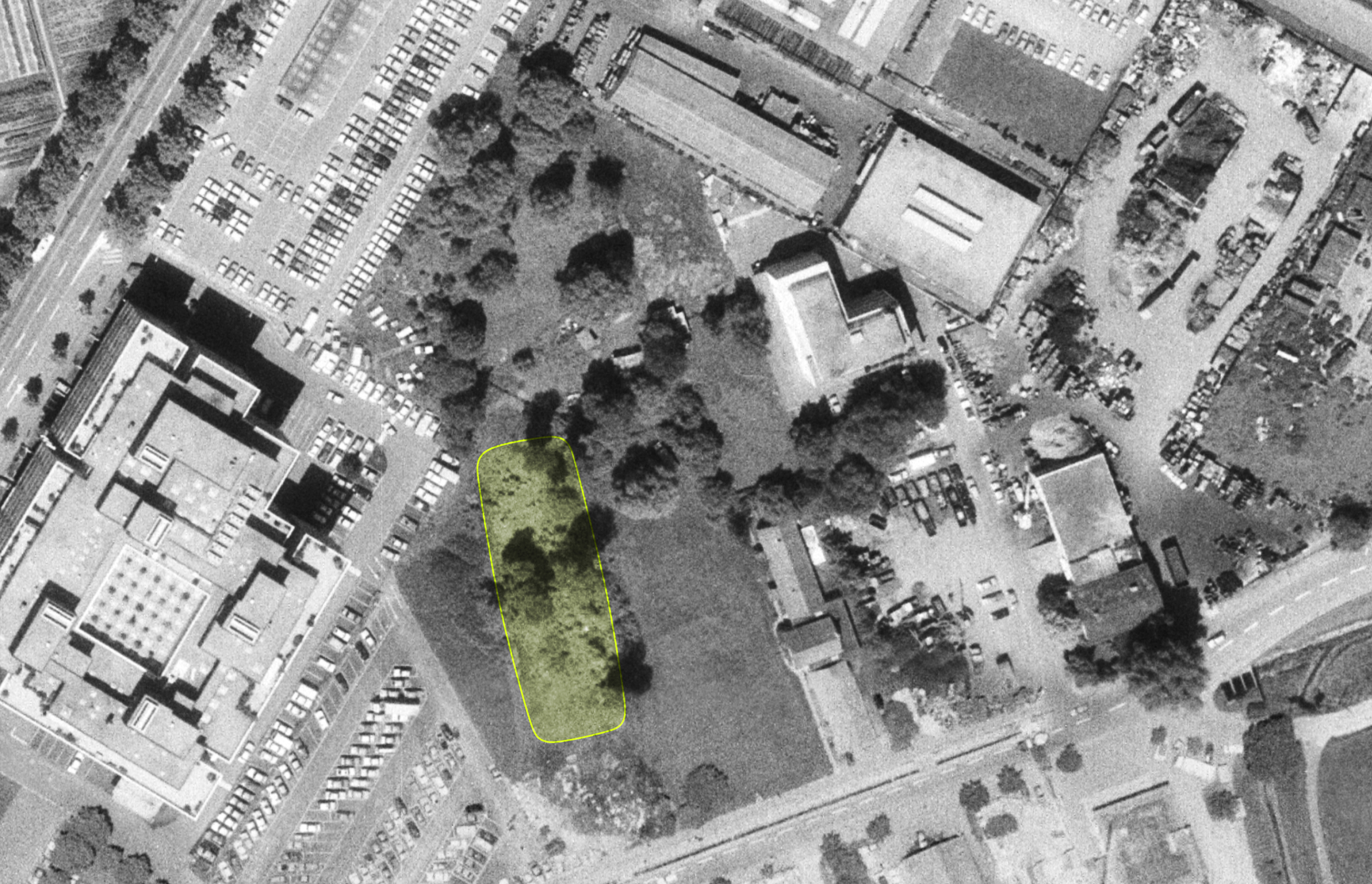
The long-drawn echo of a gunshot
But a lack of incidents doesn’t prove that everything is safe and sound. On the contrary, once the fired bullets entered the earthen wall of Büel-Seebach, they would slowly begin to degrade deep inside the trap; a process much less visible, less fast, less immediate, but nevertheless potentially harmful through the constant release of the lead and antimony they contain. Indeed, it may take years or even decades until corrosion dissolves the exterior layer of the bullets, allowing their toxic heavy metals to leach into nearby soil and water. Equally, it can take years, decades, even generations until lead poisoning takes its toll on plant life and microbial communities, as well as on human and other-than-human bodies. Chronic poisoning slowly but gradually unfolds in the nervous system, muscles, as well as the brain, causing loss of short-term memory, depression, a lack of coordination, and all sorts of mutagenic shifts. Thus, the violence of the Büel-Seebach bullet trap after 1954 may be seen as a form of “slow violence.” Coined by Rob Nixon, the term describes “a violence that occurs gradually and out of sight, a violence of delayed destruction that is dispersed across time and space, an attritional violence that is typically not viewed as violence at all.”2 Naturally, it is difficult to track, since its scales and temporalities are hard to grasp. But just because the violence at Büel-Seebach slips through the records in slow motion doesn’t mean it doesn’t exist.
Seen from this angle, Büel-Seebach becomes a paradigmatic space for the long-lasting and often unrecorded toxic legacies of shooting and military activity. In many ways, the temporality of Swiss heavy metal bullets resembles that of other toxic arms, like the radioactive, depleted-uranium ammunition used during the Gulf Wars in 19913 and 2003, and the classified nuclear bombs that were detonated by French colonial powers in the Algerian Sahara in the 1960s.4 In each of these cases, these materials have left an enduring toxic and epidemiological imprint on the land and on vulnerable human and other-than-human communities. But their delayed effects are little-known, because their slow violence is exceedingly challenging to register and to record, and because perpetrators have no interest in uncovering the consequences of their military actions. The only thing that is certain is that the toxicity will not go away on its own. If anything, it will keep creeping in: lead in soil has a half-life of 700 years.5
Contaminated home soil
Büel-Seebach, now Leutschenpark, isn’t a lonely, unique relic of Swiss shooting activities. In fact, the country is dotted with toxic bullet traps. The national environmental department reports an astonishing 2,500 active and 1,500 inactive shooting ranges across the country, which collectively have accumulated thousands of tons of lead and antimony in their bullet traps since the beginning of the twentieth century.6 This constitutes a massive, deep-seated toxic heritage. And what is worse, many of the contaminated sites are located dangerously close to settlements, animal habitats, groundwater reserves, and agricultural land.
At the turn of the millennium, the scale of the issue dawned on Swiss authorities after a new toxic-monitoring system was introduced across the country. Feeding on the ever-growing environmental consciousness, the system required all cantons to document their polluted areas and toxic waste sites.7 And the dangerously high amounts of heavy metals found in Swiss bullet traps made an immediate impact. In 2006, an amendment of the environmental law was passed that forced all shooting clubs to sanitize, replace, or remove their old bullet traps in response to these findings.8 Modern constructions, so-called artificial bullet trap systems, were mandated to replace the archaic makeshift earth walls. These new systems include artificial vessels like steel containers and big bags (gigantic, resin-filled bags) that are placed behind the targets to catch and hold the toxic projectiles, preventing heavy metals from entering the surrounding natural environment. With that ruling, it was thought, the problem was solved.
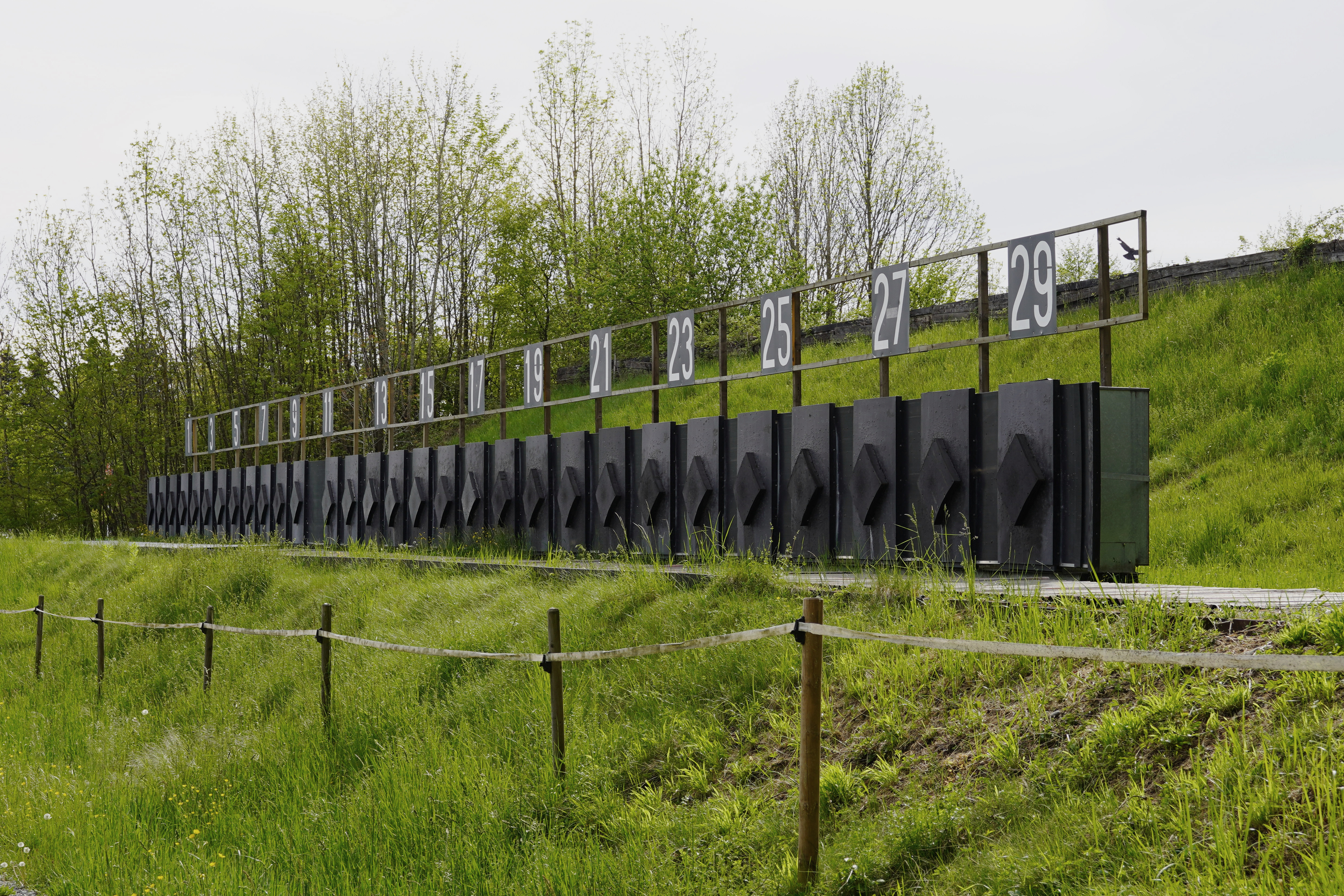
History would show otherwise. Instead of being reduced to almost zero, more than 100 tons of freshly fired lead still enter Swiss soil every year,9 surpassing the total lead emissions of the industrial sector, thus ranking sport shooting as the biggest lead polluter in Switzerland. One wonders: What happened to the bullet trap law that was designed to prevent further contamination?
A shooting nation
Naturally, there is no easy answer. But for starters, let’s consider a simple fact: Switzerland loves shooting. According to the NGO Small Arms Survey,10 there are more than 2.3 million privately owned weapons in Switzerland, which means that one in four Swiss own a gun.11 Moreover, Swiss Olympic reported in 2020 that despite a small decline over the last few years, shooting has the second-highest number of clubs (almost 2,600) and the sixth-most-active club members (more than 100,000) of any sport in the country.12
This enthusiasm for shooting has its historical roots in the country’s militia system, born as early as 1291, when the long-standing Swiss traditions of mutual aid and the duty to defend one’s home were enshrined in the first constitutional charter. In its early days, however, it was not one national but many local militias that were recruiting their members from individual towns or cantons. Only in 1815 did the system become more centralized and attuned to new geopolitical realities. That year, after decades of bloody wars, major European powers recognized Switzerland’s neutrality and guaranteed its territorial integrity in the Treaty of Paris. However, Swiss leaders had their doubts about those guarantees; too many times, treaties were violated and contracts ignored by belligerent powers in the chaos of war. As a consequence, Swiss neutrality became an armed neutrality, asserting that the country will take “military measures for the purpose of defending its neutrality.”13
Subsequently, a heavily armed militia became the centerpiece of Switzerland’s neutrality. Its aim was, and still is, to create a high degree of military preparedness through the cultivation of a nation of expert sharpshooters. Among other measures, its modern version includes the general national conscription of all male citizens ages eighteen to thirty-four,14 the ability to keep assault rifles at home after military service, and compulsory off-duty shooting practice, as well as the obligation of each municipality to operate a 300-meter shooting range (the reason for Büel-Seebach’s existence). Switzerland has no army, it is an army, as the popular saying goes.
But the Swiss militia system does not just arm people—it aims to produce both skilled soldiers and patriotic citizens. The system employs a mix of shooting-related sporting disciplines and sociocultural practices alongside explicitly military exercises like the Waffenlauf—weapons run in alpine territory; games such as Steinstossen—the tossing of huge stones; shooting festivals; and folk stories like the one of national hero, expert marksman, and giant-killer Wilhelm Tell. Through these practices, over time shooting became part of the national DNA of Switzerland, which entangles the firing of a gun with the values of autonomy and independence.
The 2006 legal ruling, then, would not easily undo centuries of nation-building shooting narratives and traditions. The tension—one could even say the contradiction—between Swiss lawmaking for and mythmaking through shooting, has been a hard one to resolve. And nowhere can we observe this struggle more clearly than at the numerous Swiss shooting festivals, where riflery turns into a great celebration of Swiss identity.
Fire at will!
Against the historical backdrop of the militia system, various Swiss shooting clubs host Historische Schützenfeste (historical marksmen’s festivals) once a year. The festivals are important cultural occasions that celebrate the founding of the country, “strengthen the patriotic spirit, foster comradery, and serve the fatherland,” as one festival puts it.15 Some of the most popular events, like the Rütlischiessen, Calvenschiessen, or Knabenschiessen16 attract thousands of competitors. The annual Eidgenössisches Feldschiessen counts a mind-blowing 150,000 shooters, while the Eidgenössisches Schützenfest hosts between 40,000 and 70,000 participants every five years.
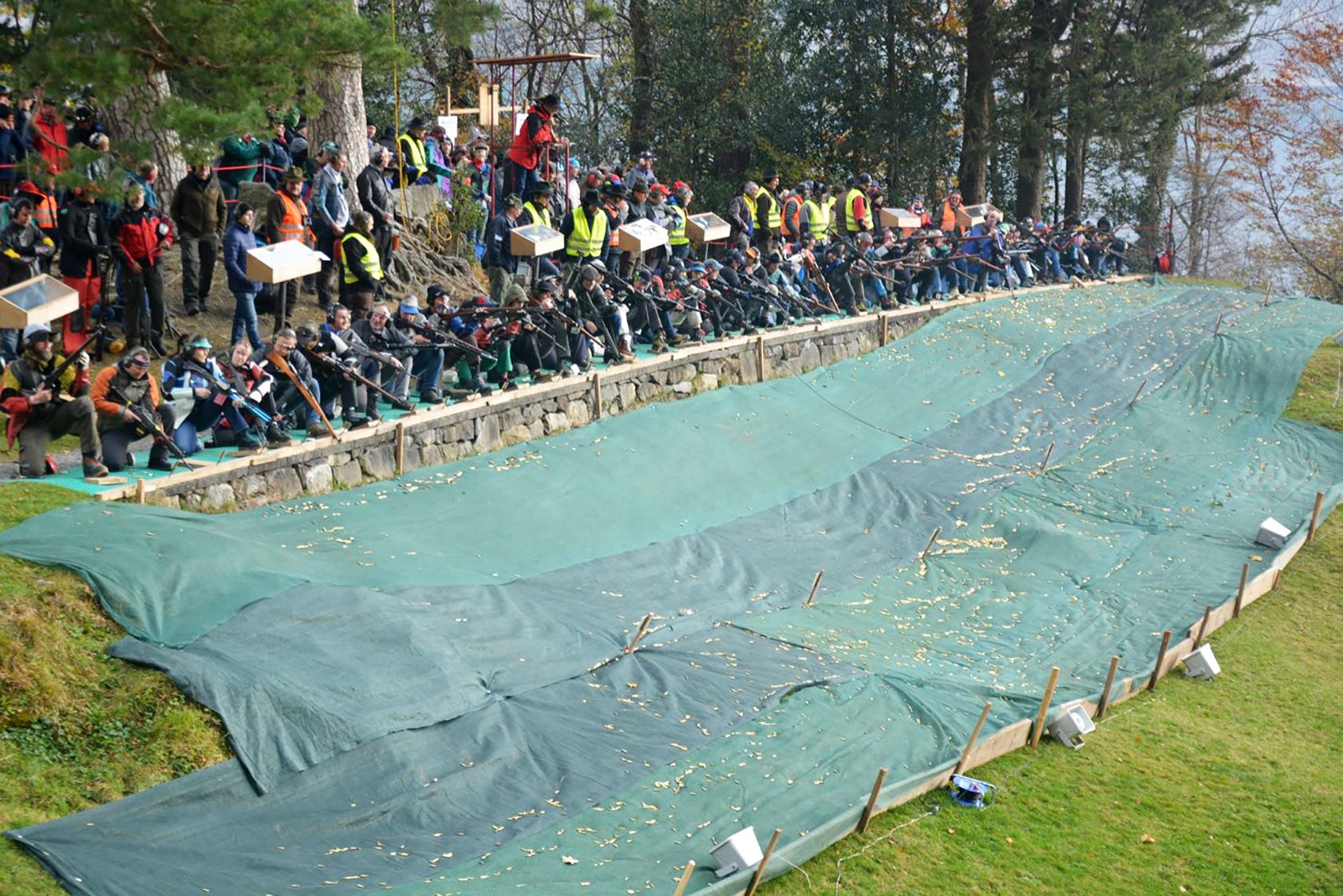
At most historical marksmen’s festivals in Switzerland, competitors must strike a target from a distance of 300 meters. Lying flat like snipers to snap off their shots following the official’s roar, “Fire at will!” they need rifles and projectiles that allow for high precision. And it is equipment like the traditional SG 550 army rifle and its ammunition, the GP 90 round—with its highly toxic composition of 95 percent lead and 3 percent antimony—that delivers.
Many of the festival organizers do not install the legally mandated modern bullet traps, because their installation in the often steep and rocky terrain poses substantial logistical and financial challenges. Instead, they rely on outdated earthen walls, allowing several tons of lead and antimony to seep into the soil each year at the festivals’ sites. Despite the 2006 amendment mandating safer bullet traps, this practice and its resulting contamination is not illegal, for the simple reason that in 2020, the aforementioned environmental law was bent in the organizers’ favor. Since then, “historical shooting events organized only once a year” could take place without the modern bullet traps. Swiss politicians wanted to “give strong support to shooting events, which are part of the historical legacy of Switzerland,” read an announcement accompanying the amendment.17 In other words, they effectively grant permission to keep firing tons of lead into the earth at more than twenty historical marksmen’s festivals each year, introducing toxins into the environment, poisoning small and large animals, and threatening agricultural lands, the food chain, and the groundwater, not to mention humans who might come into close proximity with the soil in the aftermath. It is apparently more important to have a shooting festival that contaminates the ground and country than having none at all.18
Ironically, and perhaps performatively, the official festival rules state that all fired bullets have to be meticulously counted and their position on the targets rated. But none of the organizers record the consequences of their lead- and antimony-based slow violence. In the end, those contaminated spaces are “open-ended, uncertain ecologies of the aftermath,” as Nixon calls them, because the immediate, highly accurate strikes of GP 90 bullets are outlived by their long-lasting, untracked, and utterly blurred toxic impacts.
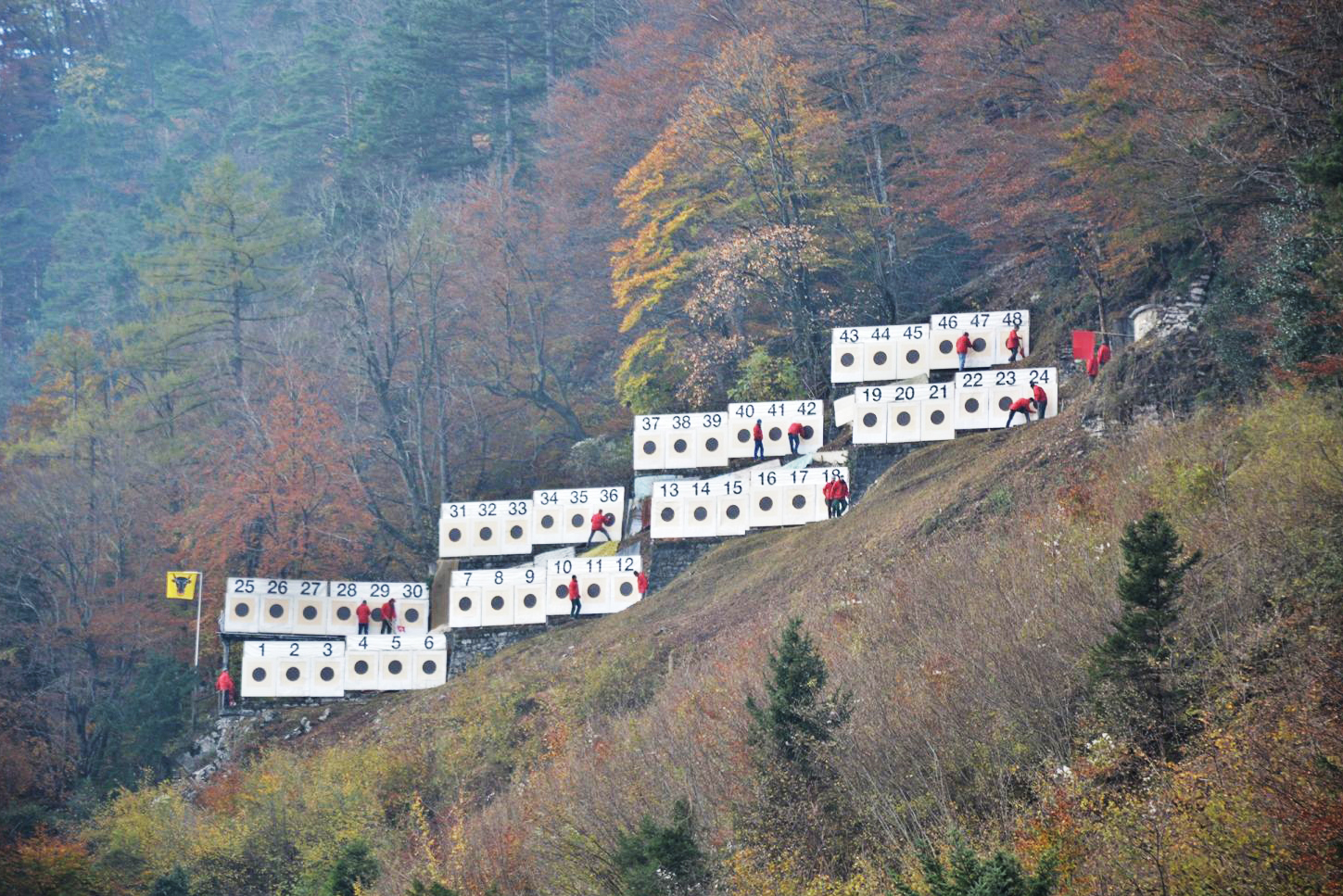
Despite this lack of clarity, it’s certainly not impossible to track this elusive violence, as a recent ruling of the European Commission proves. After environmental studies demonstrated that lead shot kills millions of wild birds annually (which mistake it for food), contaminates their predators, and threatens the food chain, the EU’s administrative body introduced a ban. Since February 2023, shooters must use nontoxic ammunition in wetlands within the EU.19 But of course, Switzerland is not an EU member state, and studies on the long-term ecological and epidemiological impacts of Swiss shooting festivals are nowhere to be found.
Worryingly, Swiss authorities not only turn a blind eye to annual shooting festivals but also show leniency when it comes to the regular activities of shooting clubs. For these almost-2,600 organizations, the enforcement of the bullet trap law advances rather slowly, to say the least. Pushed by municipalities and cantons, various legal amendments and exemptions were introduced since 2008 that helped Swiss shooting clubs obtain adjournments for the remediation of their contaminated bullet traps, claiming they need more time to get rid of their toxic earth walls.20 In response, authorities granted extensions of up to 12 years, until 2020, and now, after another amendment, in some cases even until the end of 2024.
Military (in)action
The popularity of historical marksmen’s festivals and the lax implementation of environmental laws are not the only two culprits in perpetuating a nationwide rise in toxic metals contamination. When it comes to firing heavy metals into Swiss soil, the army plays a major role too.
In its own reporting, the military acknowledges its contribution to lead and antimony pollution on Swiss soil: more than 2,200 military sites are registered in the national cadastre as contaminated shooting ranges. Yet only in 2016 did the army take the issue seriously and start its own cleanup program of the 550 most contaminated, inoperative ones. This effort is only the tip of the iceberg, as several official statements suggest that the Swiss parliament hasn’t effectively allocated enough money to clean and sanitize all ranges in a reasonable amount of time.21 It seems there are simply too many sites against the limited financial resources provided by the parliament. Therefore, the remediation program sets clear priorities: sites close to groundwater reserves and agricultural land, as well as sites that should be sold or built on, are considered “most urgent” and addressed first. The range in Düdingen is one such site. There, about 8 million projectiles and 58 tons of lead were buried right next to a water treatment plant. Other sites will have to wait, and likely for decades. In light of the Russo-Ukraine war, priorities lie elsewhere: recently, Swiss authorities found the means to allocate 7 billion francs to enhance the defensive capabilities of the country and acquire more anti-aircraft guns, weapons and, of course, ammunition.
As we dig deeper into the specifics of the army’s bullet trap cleanup program, more controversies emerge. Numbers are changing in “sustainability reports”—and not for the better. In 2018, these reports listed 2,000 contaminated shooting ranges and 296,000 m² of cleaned-up areas, whereas 2,200 sites, and a reduced number of cleaned-up areas (down to 98,800 m²) were recorded in 2021. How is it that the cleaned area actually got smaller by 50 percent? Whatever the answer, one can’t help but speculate over the true scope and impact of both the army and the festival sites across the country. Because even in the absence of verified numbers, one thing is certain: these contaminated places will slowly but surely affect nearby habitats and communities—if not in this generation, then in those to come.
Deferral and denial
Back in Zurich, in Leutschenpark, it’s late in the afternoon. The autumn sun edges its way toward the horizon and bathes the park in a gentle tint of golden gray. All around, visitors ebb and flow, walking their dogs, chatting on their phones, rushing for the tram home. Unfazed by the buzz of the city, the bullet trap stands there monolithically. And while the blank barrier “hides” its toxic interior from passersby, its harsh architecture of segregation unmistakably highlights its essential logic of deferral. First a fence, and then a wall mark the futile attempts to hide and postpone the slow violence of a poisoned place.
When tendering for the design of Leutschenpark began in 2002, city officials knew that the bullet trap would pose an issue—it was clear that the ground was still heavily contaminated. Rigorous analyses had been carried out on a regular basis, and the evaluated lead levels were shown to exceed critical thresholds. For this reason, “The soil of the bullet trap should have been categorized as toxic waste, excavated and deposited” before any building works could start, says Felix Schuppisser, an environmental engineer who assessed the soil samples then.22
But the park was a strategically important and potentially lucrative investment site in a gentrifying quarter, and the remediation of the bullet trap would have been time-consuming and expensive, impeding development opportunities. In addition to the 13 million francs necessary for constructing the park, the remediation would have incurred an additional 3.4 million francs. Hoping to avoid further expense, local politicians awarded the first prize of the design competition to Dipol Landscape Architects of Basel, who proposed a cheap solution circumventing any remediation measures. To do so, they made use of an old legal clause that stated that toxic waste sites don’t have to be cleaned up provided the hazardous waste can be fixed in place and won’t move, flow, or escape in any other way. For good reason, the clause has been tightened drastically since 2008, but its history lives on in the grotesque wall design, which, in outdated legal terms, “secures” the toxic hill.
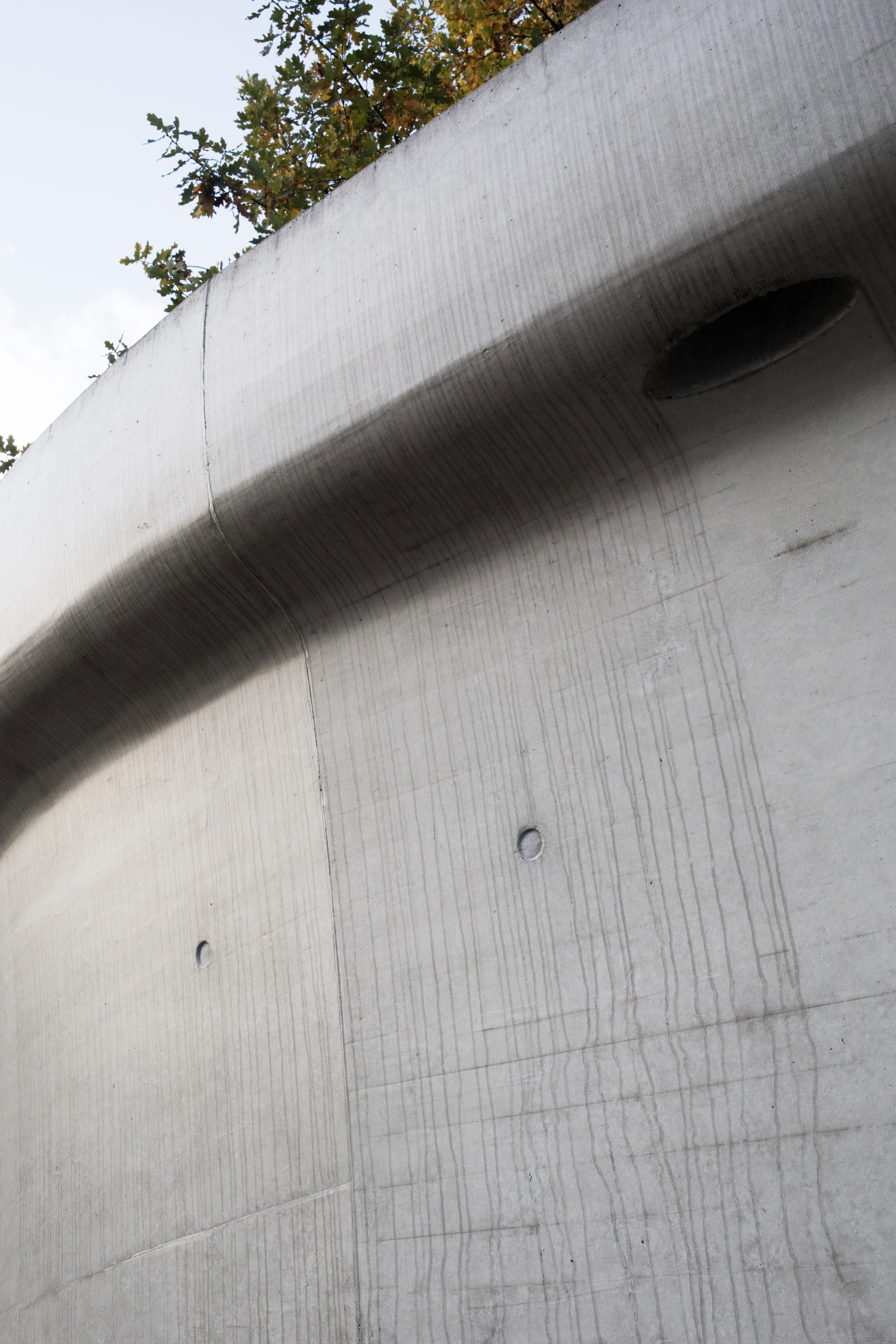
What does it even mean to “secure” a toxic hill? I called an employee of Jäckli Geology, the company in charge of soil surveys during and after the construction of Leutschenpark, to ask that very question, and was told that it is “very secure.” First, a 3.5-meter-high wall is a surefire way to keep children and pets from entering the site. And second, the geological layers underneath the bullet trap are supposedly dense enough to prevent toxic particles from flowing into the subjacent groundwater reserves. “But I do not say that we haven’t experienced any problems with the bullet trap,” the geologist went on. “For example, increased levels of lead were measured in the groundwater when the park was under construction,” indicating that even minor seismic events can release the heavy metals. On top of that, he explained, several contaminated patches of soil were found close to Leutschenpark over the last fifteen years. It might be the result of a series of relocations of parts of the earth wall for former building works. Nobody knows how much toxic soil was moved or how many times it was moved, let alone where it was moved to.
Whether a wall is the appropriate measure to stop lead and antimony from escaping a bullet trap remains disputable. Several studies conducted in Switzerland during the last twenty years conclude that both substances pose considerable short- and long-term threats, particularly to water resources and host organisms that provide nourishment and shelter for smaller organisms. When it rains, antimony—and under certain soil conditions, the usually rather sluggish lead—becomes highly water-soluble and mobile. Slowly but continuously, these elements seep down, breaking their way through layers of earth, following so-called preferential flow paths into deeper layers of subsoil. And “although there is not an imminent risk for groundwater contamination” posed by toxic bullet traps, “the lead or antimony plumes could in the long term reach the groundwater table, if the soil is not remediated,” chemist Irene Xifra Olivé concludes in her 2006 PhD thesis.23
Despite this scientific evidence, authorities and Dipol pressed on with their plans. In 2008, Leutschenpark was constructed and the concrete barrier erected. Seen in this light, the glaring visibility of the architectural construction turns into a materialized form of spatial and temporal denial—as Nixon would describe it—utilizing the strategy of “out of sight, out of mind.”
Building walls, building narratives
At Leutschenpark, as dusk falls, I see not only a 3.5-meter-high gray barrier, I sense a monumental deception, a false promise that the incessant movement of matter can be halted by fences and walls, if they are high, thick, and stable enough. Yet this image of enclosure and imprisonment doesn’t hold true. Not for Leutschenpark, nor for the most modern versions of bullet traps. Supported and prescribed by the state as a solution to the further intoxication of bodies and land, these structures promise to catch fired bullets, seal their toxic components, and isolate their heavy metals from the environment for as long as we wish. Yet aside from the fact that their current implementation moves at a snail’s pace, they are doomed to fail. After all, these containers can store only a limited number of projectiles: usually around 10,000. Once this threshold is reached, the highly toxic slags must move somewhere else. And although the poisonous remains are buried at special disposal sites deep underground, it doesn’t mean that they are immobilized, shut off, or pushed to an “outside” where they are isolated from the world. As at Leutschenpark, toxic slags keep trickling, seeping, flowing, mutating, and acting in all sorts of ways, possibly for centuries. Poisonous particles never go out, they just go around, as biologist Lynn Margulis says.24
Nevertheless, walls, fences, barriers, and containers—like the one at Leutschenpark and the manifold versions at active Swiss shooting ranges—sustain the myth of control over what stays in and what goes out. Thereby, as political theorist Wendy Brown notes, their seemingly impenetrable structures create not only a physical reality but also an image of the sovereign and secure state.25 These walls and containers suggest, incorrectly and tragically, that the Swiss authorities are in control of the problem. They keep up the powerful illusion that material flows of lead and antimony can be managed safely, so that a whole nation can flee its responsibility and continue firing toxic bullets for the sake of military power, patriotic sentiment, and mythical nation-building.
This tempting but shortsighted mirage of control over toxic residues won’t lead to a happy ending. No matter how many structures of separation Swiss authorities introduce, the poisonous projectiles will still slip through and circulate in the environments we inhabit, as well as in our very own cells, bodies, and communities for an unimaginable period of time, with unforeseeable consequences. The only way to stop the ongoing intoxication, then, is not to install more concrete quarantines, cages, and containers. It would be to stop shooting toxic bullets once and for all, accepting the loss of a Swiss tradition.
As night settles at Leutschenpark, the space has emptied, and the edges of the wall fade into the darkening urban background. As I make my exit, I suddenly hear a strange humming noise. I turn around and am taken by surprise. Suddenly, the meandering light installation is turned on and bathes the concrete barrier in a blaze of blue light. Observing the wall in this radiant color, I recognize it once again as what it is: a meticulously camouflaged, paradigmatic space of contamination where culture, politics, and the invisible aftermath of an environmental catastrophe clash full-on.
As I leave Leutschenpark, imagining sharpshooters over centuries here and elsewhere in the country, I start to sense the bang of bullets. Their sounds arrive from the past, present, and future and blend into a multitemporal, strident cacophony. Step by step, I move farther away from the wall. And as the artificial blue light is swallowed by the darkness of the night, the poisonous bangs ceaselessly reverberate.
-
Arnold Seebach, a local historian from the Ortsgeschichtliche Sammlung Seebach (the historical collection of Seebach; a club that traces the local history of the quarter), told me in an email conversation in October 2022 that he thinks that the contaminated area was fenced off “mostly after 1955” but as far as he remembers, not equipped with a warning sign that informed citizens about the toxic content of the soil. ↩
-
Rob Nixon, Slow Violence and the Environmentalism of the Poor (Cambridge, MA: Harvard University Press, 2011), 2. ↩
-
Akira Tashiro, Discounted Casualties: The Human Cost of Depleted Uranium, trans. Transnet (Hiroshima: Chigoku Shimbun, 2001), 94–95. ↩
-
Jill Jarvis, “Radiant Matter: Technologies of Light and the Long Shadow of French Nuclear Imperialism in the Algerian Sahara,” Representations 160, no. 1 (2022): 56. ↩
-
See Sanjeet Bagcchi, “Remove Lead from Soil to Save Children from Toxicity,” SciDev.net, February 2, 2021, link. ↩
-
Bundesamt für Umwelt (BAFU), “VASA-Abgeltungen bei Schiessanlagen,” 2020, 6. ↩
-
Swiss environmental awareness grew during the 1970s and 1980s, after various national and international environmental crises—like the oil crises, the discovery of the hole in the ozone layer, the massive pollution of the Rhine River by a Swiss chemicals company, and “Limits of Growth,” a report by the Club of Rome—revealed the dramatic ecological consequences of industrial activities and consumerist societies heedless of the environment. And while the environmental law was enshrined in the Swiss constitution in 1985, there were no strict rules for waste disposal promulgated until 1997. According to a document from the environmental department, only then was water contamination and odor pollution clearly linked to unaddressed waste contamination and unregulated landfills—and led to further legislation regarding toxic waste. ↩
-
Noncompliant ranges would be closed, but shooting clubs were promised that the authorities would aid in the cleanup by bearing 40 percent of the costs. ↩
-
BAFU, “VASA-Abgeltungen bei Schiessanlagen,” 6. ↩
-
Aaron Karp, “Estimating Global Civilian-Held Firearms Numbers,” Small Arms Survey Briefing Paper, June 2018. ↩
-
This ranks Switzerland 19th by ownership globally; the ranking is led by the U.S., with 120.5 firearms per 100 persons. Karp, “Estimating Global Civilian-Held Firearm Numbers.” ↩
-
Angela Gebert, Markus Lamprecht, H. P. Stamm, and Rahel Bürgi, “Swiss Olympic Verbandsbefragung 2020,” Lamprecht & Stamm Sozialforschung und Beratung. ↩
-
Lassa Oppenheim, International Law: A Treatise, vol. 2, War and Neutrality (London: Longmans, Green, 1906), 325. ↩
-
With a system of civil defense service as an alternative. ↩
-
Sicherheitsdirektion Kanton Uri: Projektdossier Historisches Rütli-Pistolenschiessen, 3. ↩
-
At this shooting festival, Zurich boys and girls between ages thirteen and seventeen can participate for the admission price of 12 francs, for which they get ammunition and a sausage. ↩
-
Swiss Federal Council, “Historische Schiessen: Neue Bestimmungen über die Finanzierung von Sanierungen treten am 1. März 2020 in Kraft,” press release, February 2020. The announcement stated as well that the costs for the installation of modern bullet traps at historical marksmen’s festivals would be partially covered by the state, if the organizers choose to install them. However, the installation is still not mandatory, but voluntary. ↩
-
Tellingly, the historically important site of the Rütlischiessen—where, according to legend, the founding fathers of Switzerland established the Swiss Confederacy—is especially heavily contaminated today. The annual shooting festival left its mark: Since 2011, the earth of the meadow has had to be excavated twice due to the lead saturation levels in the soil. ↩
-
Phoebe Weston, “Ban on Hunting Birds with Lead Shot in EU Wetlands Hailed as ‘Huge Milestone,’” Guardian, February 15, 2023. ↩
-
Preliminary draft of the parliamentary initiative regarding the remediation of Swiss bullet traps: Deadline extension until 2012 (number 07.429, April 2008), 4. ↩
-
For example, see the two sustainability reports published by Armasuisse (a real estate organization, which is part of the Department of Defense) from 2018 and 2021: Armasuisse Immobilien, “Nachhaltigkeitsbericht 2018,” 26, and “Nachhaltigkeitsbericht 2021,” 27. ↩
-
The statement of Felix Schuppisser is part of the video Das Geheimnis des Baumtopfs im Leutschpark (2009), a documentary about Leutschenpark’s history and redesign, commissioned by the City of Zurich. Viewed in the municipal archive on October 25, 2022. ↩
-
Irene Xifra Olivé, Mobility of Lead and Antimony in Shooting Range Soils (PhD diss., ETH Zurich, 2006), 119. ↩
-
Lynn Margulis in the film The Tissue of Gaia (1993), cited in Critical Zones: Observatories for Earthly Politics (field book Paris 2010–2011/Museum Tinguely, Basel, 2011), S.56–63. ↩
-
Wendy Brown, Walled States, Waning Sovereignty (Cambridge, MA: MIT Press, 2010), 21. ↩
Christoph Miler is an author, designer, and educator based in the Netherlands and Switzerland. His writing explores the fields of migration, technology, and the environment through essays, interviews, and experimental poetry. Together with Isabel Seiffert he formed the design studio Offshore. Their work focuses on design education, editorial design, image-making, and research-oriented visual narratives.
